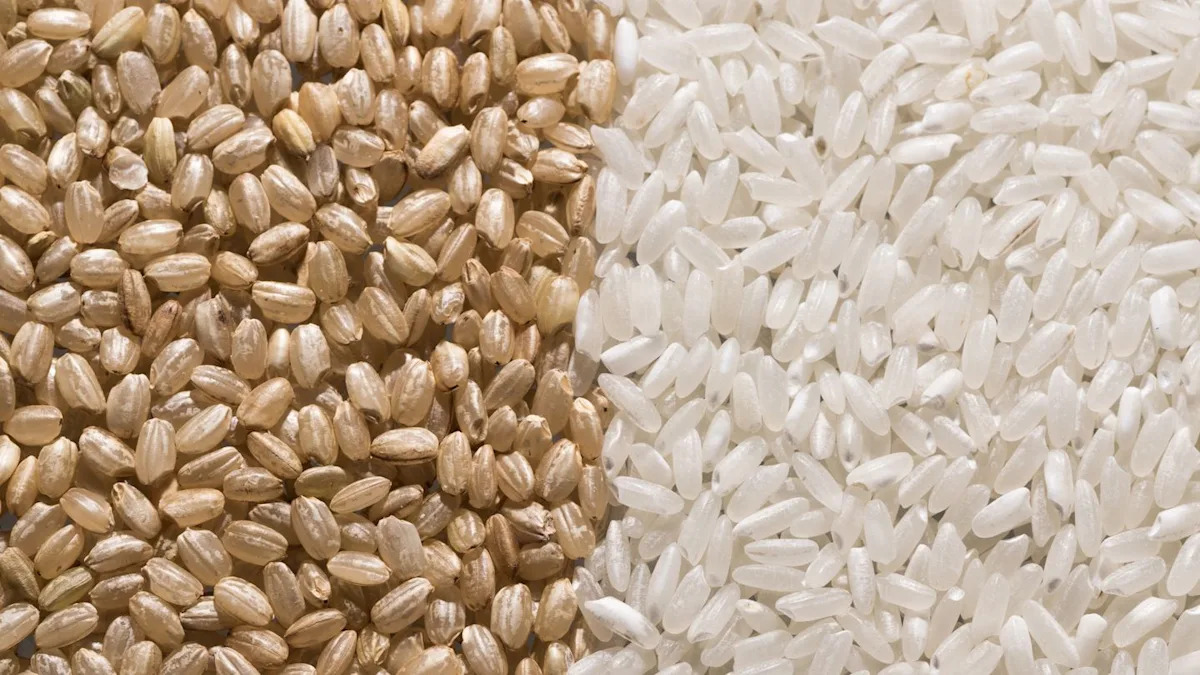“Hearst Magazines and Yahoo may earn commission or revenue on some items through these links.”
The pressure to make healthy mealtime choices can boil down to brown rice versus white rice—which one is better? And the decision can feel extremely high-stakes. But it doesn’t have to be. Rice is a world renowned, reliable side dish for good reason. It’s a generally accessible, healthy, and versatile grain. But there are differences between types to consider.
Meet the Experts: Maya Feller, M.S., R.D., C.D.N., registered dietitian nutritionist at Brooklyn-based Maya Feller Nutrition; Catherine Perez, M.S., R.D., registered dietitian and owner of Plant-BasedRD; Tessa Nguyen, MEd, R.D., L.D.N., professional chef, registered dietitian, and founder of Taste Nutrition Consulting; Janet Brill, P.h.D., R.D.N., F.A.N.D., registered dietitian and author of Cholesterol Down; and Destini Moody, R.D., C.S.S.D., L.D. dietitian at Live It Up.
White rice, in particular, has gotten a bad reputation over the years. We spoke to dietitians to explain why, and lay out how brown rice and white rice compare so that you can confidently make the best choice for you.
Brown rice vs. white rice
The main difference between the two is that brown rice is a whole grain, explains Catherine Perez, M.S., R.D., registered dietitian and owner of Plant-BasedRD. “Whole grains maintain both their bran and germ, [two of the three main parts of a whole grain,] while processed grains usually have this coating removed,” she says.
White rice, like many other white grains (i.e. bread, flour), loses the majority of its nutrients when that coating is stripped, and so, “white” grains are often categorized as “bad” foods that can elevate blood sugars or contribute to diabetes and weight gain, Perez says. There’s also a school of thought in nutrition that white rice is the poor choice because it’s lower in fiber than brown rice. But it isn’t that simple.
The truth is, white rice is accessible, convenient, quicker to cook, and a staple for many communities of color that has received a lot of judgment from “a foundation in racism and whiteness because brown rice is seen as the elite choice for nutrition and is found readily in stores in affluent areas,” explains Tessa Nguyen, MEd, R.D., L.D.N., professional chef, registered dietitian, and founder of Taste Nutrition Consulting.
Both types can be used interchangeably in recipes, but white rice tends to be softer and fluffier while brown rice is heartier and slightly chewy, she adds. Calorically and carbohydrate-wise, the two types of rice are very similar. Keep reading for a full breakdown of their nutrition.
Brown rice vs. white rice nutrition
The nutritional value of one cup of brown rice, according to the United States Department of Agriculture (USDA), is:
The nutritional value of one cup of white rice, according to the USDA, is:
Benefits of brown rice
This complex carbohydrate is a good source of fiber, which can improve satiety or fullness after a meal. High-fiber foods make you feel fuller on less calories because they take longer to digest, which can help with weight loss.
Brown rice is a whole grain and is a source of B vitamins, potassium, manganese, and selenium. Because brown rice is a complex carbohydrate, it also provides vitamins and minerals (like iron) and can provide more energy than white rice, Perez says.
Perez says the whole bran and germ can also deliver antioxidants and phytonutrients, which, paired with fiber, can support gut and immune health, as well as cardiovascular health. Studies show that brown rice contains phenolic acids, which are the most common antioxidants in our diet that reduce the risk of cardiovascular disease, type 2 diabetes, obesity, and certain cancers.
Cons of brown rice
On the flip side, brown rice may be difficult to digest because it contains an anti-nutrient known as phytate that can hinder your body’s ability to absorb certain minerals from food, according to one study. As previously mentioned, brown rice also takes longer to cook. A February 2025 study published in Risk Analysis also reviewed brown rice and detected arsenic in all 145 types that were tested, but determined no general public health risk associated with the findings. (More on that below.)
Benefits of white rice
“When enriched, white rice will have a variety of vitamins and minerals so the differences between brown and white rice are not so significant,” says Maya Feller, M.S., R.D., C.D.N., registered dietitian nutritionist at Brooklyn-based Maya Feller Nutrition and author of Eating from Our Roots: 80+ Healthy Home-Cooked Favorites from Cultures Around the World. Food labels and packaging will call out if rice is enriched. White rice also provides energy like any other carbohydrate. And although brown rice has more fiber, white rice still has some, which is worth pointing out.
“One of the most important benefits of white rice is that it is integrated into many cultural cuisines,” Perez adds. “White rice is surrounded by tradition, family, and connection. It goes beyond just physical nourishment. Being able to keep parts of your culture alive absolutely feeds you mentally and helps fulfill you too.”
If you don’t add fat (say, in the form of butter), white rice is low in calories and paired perfectly with with vegetables or lean protein. Our experts note that it also may be easier to digest than brown rice because of its lower fiber content.
Cons of white rice
White rice may increase blood sugar, especially if over-consumed, as it’s higher on the glycemic index, one study noted. The aforementioned processing could mean it has less nutrients, but many brands are re-enriched with the good stuff. Lastly, white rice is not as good as a source of fiber as brown rice is, and fiber is “sorely lacking in most Americans’ diets,” says Janet Brill, P.h.D., R.D.N., F.A.N.D., registered dietitian and author of Cholesterol Down.
Is white or brown rice healthier?
Eating brown rice is a great way to increase your whole grain intake, but both have their benefits, Perez says. When it comes down to it, Perez suggests choosing whichever you love to eat and making sure all elements of your plate meet your nutrition goals.
White rice is rarely consumed on its own, and you have an opportunity to pack in a ton of nutrients with the other ingredients like fresh vegetables and lean protein, so the type of rice doesn’t make that much of a difference, Perez says. It can come down to personal preference. “People should make food choices based on affordability, accessibility, current health status, and cultural relevance,” Feller says.
Can I eat rice every day?
“If someone wants to eat rice each day it’s absolutely ok,” Feller says. “There are a number of cultures around the globe that eat rice as a staple part of their pattern of eating.” As with any food, Brill says portion control is important for those looking to maintain or lose weight, and if you are managing your blood sugar, consult your doctor or a dietitian about eating it in ways that work for you.
Why did people stop eating brown rice?
You may have heard of people steering clear of brown rice after a February 2025 study detected arsenic—a toxic element that is part of the earth’s crust and ends up in soil, water, and the environment—in a lot of it. In its inorganic form, arsenic is considered a carcinogen, according to the World Health Organization. However, the brown rice tested in the recent study contained arsenic because of where it was grown, and because it isn’t processed and therefore stripped of its natural state. Therefore, the study found that these small potential exposures posed no acute public health risks to the general American population.
With that being said, Destini Moody, R.D., C.S.S.D., L.D. dietitian at Live It Up says she doesn’t see brown rice disappearing. “I actually feel as if brown rice is more popular now than I’ve seen it in my professional career,” she says. “I believe this has something to do, in part, with more public awareness about the health benefits of eating for more controlled blood sugars.” People are also wanting to eat less refined grains in excess, she adds.
What is the best rice for weight loss?
“Even throwing in the likes of black, red, and wild rice, I’d still say brown rice is the best for weight loss,” says Moody. “Though all rice is similar in calorie content, the high fiber content of brown rice means it hangs out in the stomach for longer, making the meal feel more satisfying for a longer period of time. This level of hunger control can help one eat less throughout the day and can prevent one from feeling as if they are starving while dieting in a calorie deficit.” The consumption of brown rice has even been linked to lower body weight.
You Might Also Like
First Appeared on
Source link












